Dangerous goods are substances, being solids, liquids or gases, that may cause harm to people, property and the environment. As these substances pose major risks to the organisations that carry them, it’s important that everyone within the workplace is aware of the dangerous goods that are present. This can be achieved by displaying clear, compliant dangerous goods warning signage and hazard signage in all relevant storage and handling areas. In this post, we’ll be explaining the importance of dangerous goods signage, as well as outlining the specific requirements for your chemical storage cabinets.
Why Is Chemical Storage Signage Important?
Simply put, dangerous goods signage allows workers to identify the dangerous substance being stored. It also warns them of any potential hazards associated with the specific class of dangerous goods being stored.
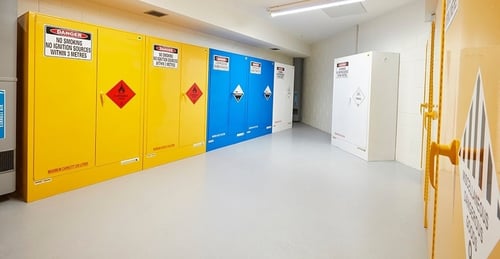
Your chemical storage cabinet must feature the correct dangerous goods signage for the goods that are being stored.
When dangerous goods are stored in chemical storage cabinets, the correct dangerous goods signage must be displayed to warn workers of the potential hazards. This will then allow all staff, supervisors and contractors to follow the set procedures for the handling and storage of these dangerous substances.
Chemical Storage Cabinet Signage
Each class of dangerous good has a different sign that presents the specific risk associated with that hazard class. We often refer to this sign as a ‘dangerous goods diamond’.
All chemical storage signage requirements for safety cabinets are outlined in the relevant Australian Standard. You must refer to the Standard that relates to the specific class of dangerous goods that is being stored.
In addition to this, the design requirement for dangerous goods signs that must be applied to chemical storage cabinets are outlined in the Australian Standard AS 1216-2006 - Class labels for dangerous goods. In the next section of our post, we’ll explain the dangerous goods sign that is required for each of the chemical storage cabinets.
Explosives Storage Cabinets
The signage requirement for explosive storage cabinets is outlined in the Australian Standard AS 2178-1998.
This Standard states:
2.1.3 Marking
The magazine shall be marked on the door or lid as follows:
(b) A Class 1 label is to be used in accordance with the requirements of AS 1216, of minimum size of side 250 mm except for internal portable magazines or external portable magazines with a capacity less than 60 kg or 500 detonators.
Therefore, when storing explosives, you must use a Class 1 dangerous goods label. An example of a Class 1 label is shown below:
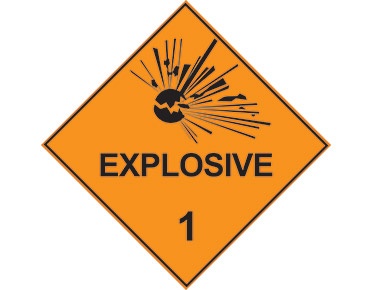
Flammable Liquids Storage Cabinets
The Standard that sets out the dangerous goods signage requirements for flammable liquids storage cabinets is AS 1940-2017.
The Standard explains that:
4.9.4 Cabinet Marking
Each cabinet shall be marked with—
(c) a Class 3 dangerous goods label with sides of at least 250 mm nominal length;
Therefore, all chemical storage cabinets storing flammable liquids should be marked with a Class 3 - Flammable liquids label. An example of this sign is shown below:
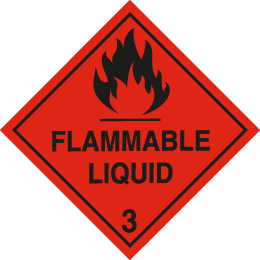
DID YOU KNOW Compliant Class 3 Flammable Liquids storage cabinets are constructed with a thermal air barrier to provide protection for your chemicals in the event of a fire. This allows a 10-minute window to evacuate the building and activate fire extinguishing equipment.
Flammable Solids Storage Cabinets
The Australian Standard that sets out the specifications for the dangerous goods signage required for chemical storage cabinets storing flammable solids is AS/NZS 5026-2012.
Section 5 explains that:
5.7.4 Cabinet Marking
Each cabinet shall be marked with—
(c) the relevant dangerous goods division label with sides of at least 250mm nominal length
All signs and markings shall be clearly visible when the cabinet doors are closed.
Therefore, all chemical storage cabinets used to store flammable solids must clearly display the relevant dangerous goods division label. These division labels will either be; Division 4.1 Flammable solids, division 4.2 Substances liable to spontaneous combustion or division 4.3 Dangerous when wet. Examples of these class labels are shown below:
Class 4.1 - Flammable solids
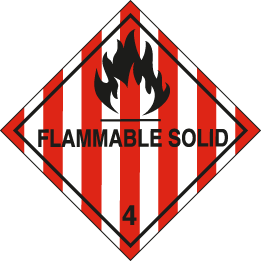
Class 4.2 - Spontaneously combustible
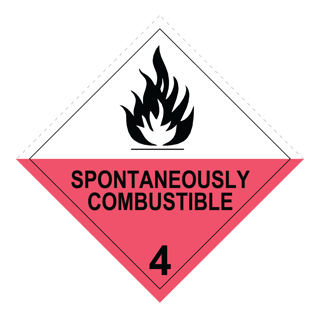
Class 4.3 - Dangerous when wet
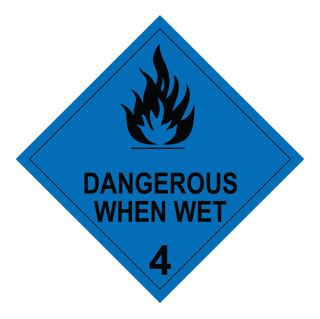 Oxidising Agents Storage Cabinets
Oxidising Agents Storage Cabinets
Section 10 of AS 4326-2008, the Standard for oxidising agents, states that:
10.3 SIGNS AND PLACARDS 10.3.1
Placarding of stores
Unless otherwise required (e.g. by regulation), signs shall comply with AS 1319. Class labels shall conform with AS 1216 and be a minimum of 250 mm square. Composite signs or graphics symbols complying with these requirements may be used.
Therefore, chemical storage cabinets used for storing oxidising agents must be labelled with a “Class 5.1-oxidising agent" sign that complies with AS 1216. An example of this label is shown below:
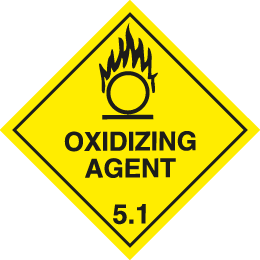
IMPORTANT: Oxidising agents have the ability to oxidise other substances. Therefore, the compliant storage and handling of these chemicals is required to help protect workplaces against hazards such as oxidising reactions.
Organic Peroxides Storage Cabinets
The standard that specifies the dangerous goods signage requirements for organic peroxide storage cabinets is AS 2714-2008. Section 4 of this standard explains that:
4.6.3 Cabinet Marking
Cabinets shall be marked in accordance with Clause 6.3.
Section 6 of this Standard states:
6.3 PLACARDING
6.3.1 Placards and warning signs
Stores shall be placarded in accordance with the NOHSC:1015. Placards and signs shall be maintained so as to be legible. Placarding shall reflect the actual storage situation at any given time and shall be amended without delay.
These additional signs shall have lettering that contrasts with the background and is clearly legible from any access point. Unless otherwise required, the letters shall be at least 50 mm high. All signs shall comply with AS 1216 and AS 1319. Composite signs or graphic symbols complying with these requirements may be used.
As the Standard states that the “placarding must reflect the actual storage situation” and that “all signs must comply with AS 1216”, a Division 5.2 Organic Peroxide label must be applied to all cabinets storing organic peroxides. An example of this sign is show below: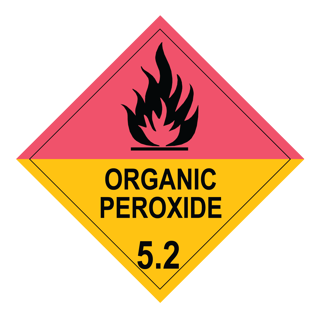
Toxic Substances Storage Cabinets
The Australian Standard that specifies the dangerous goods signage requirements for toxic substances is AS/NZS 4452 - 1997. Section 4 of this standard states:
4.4.2.6 Cabinet Marking
Cabinets shall be marked in accordance with Clause 7.4.1
Section 7 states:
7.4 PLACARDING
7.4.1 Placarding of stores
Every installation where toxic substances are kept shall be placarded in accordance with the Worksafe Australia “Guidance note for placarding stores for dangerous goods and specified hazardous substances”.
Therefore, Worksafe Australia's “Guidance note for placarding stores for dangerous goods and specified hazardous substances” must be followed for dangerous goods signage requirements for toxic storage cabinets.
This document states:
Guidance Note for Placarding Stores for Dangerous Goods and Specified Hazardous Substances [NOHSC:3009(1990)]
PACKAGE STORES 6.6
Package stores are to be placarded with a composite warning placard.
Composite Warning Placard 6.7 The composite warning placard is to show:
The Class label, with sides of at least 100 mm, for the class of dangerous goods stored.
Therefore, all toxic substance storage cabinets must display a Division 6.2 - Toxic Substance label. An example of a toxic substance label is show below:
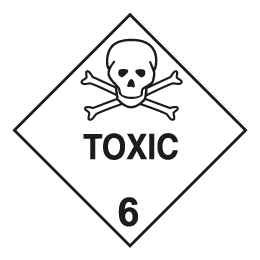
REMEMBER: Toxic chemicals can harm people, animal and the environment if they leak or spill. And although your chemical cabinet is equipped with a liquid-tight spill containment bund, it’s your duty to ensure that any leaks or spills are detected and cleaned-up as quickly as possible.
Corrosive Substances Storage Cabinets
The Australian Standard that specifies the dangerous goods signage requirements for corrosive substances storage cabinets is AS 3780-2008. Section 4 of this standard states:
4.6.7 Cabinet Marking
Cabinets shall be marked in accordance with regulatory requirements. Where there are no such requirements, each cabinet shall be marked with—
(c) a Class 8 dangerous goods label with sides of at least 100 mm nominal length.
All signs and markings shall be clearly visible when the cabinet doors are closed.
Therefore, a Class 8- Corrosive substances label must be placed on all corrosive storage cabinets. An example of this sign is shown below:
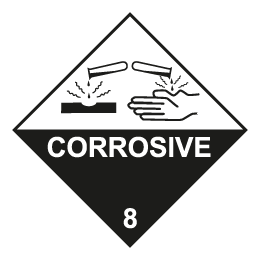
Miscellaneous Dangerous Goods Storage Cabinets
AS/NZS 4681-2000 is the Standard that explains the signage requirements for cabinets that store miscellaneous dangerous goods. Section 1 of this Standard explains that:
1.6 MARKING OF PACKAGES
Packages containing dangerous goods or articles shall be marked in accordance with the appropriate Australian State or Territory or New Zealand legislation.
NOTE: In Australia, labelling in compliance with the ADG Code, NOHSC: 2012 and the SUSDP may be required under such legislation.
Therefore, a Class 9 - Miscellaneous Dangerous Goods sign that complies with AS 1216 must be placed on all miscellaneous dangerous goods storage cabinets. And the signage requirements specified in AS 1216 are based on the requirements in the ADG Code.
AS/NZS 4681-2000 states that the signage requirement must comply with the ADG Code. Therefore, a Class 9 - Miscellaneous Dangerous Goods label is a compliant signage option for miscellaneous dangerous goods cabinets. An example of a compliant miscellaneous dangerous goods sign is shown below: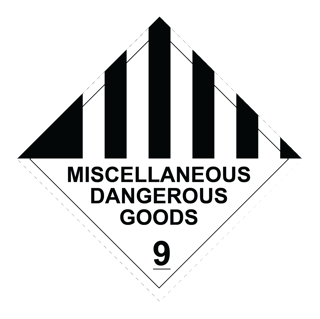
Dangerous Goods Signage For All Workplace Safety Cabinets
To maintain a safe and compliant workplace, it’s vital that all staff, supervisors and contractors are aware of the dangerous goods stored onsite. As we’ve detailed in this blog, varying classes of dangerous goods need different signage to display their particular hazards. These can be found in the relevant Australian Standards that relate to the goods that are being stored in the workplace.
Another key safety consideration when storing dangerous goods is ensuring that incompatible classes are separated. If incompatible classes of dangerous goods mix, they can cause hazards including violent chemical reactions. If you’d like to learn more about the correct segregation of incompatible classes of dangerous goods, you can download our free guide. Our eBook will lead you through the segregation requirements, so you can keep your dangerous goods safely stored. Click on the below image to access your copy today.
Joining the team as a Dangerous Goods Storage Consultant, Melissa Hampton became Storemasta's Marketing Manager in late 2021. With extensive knowledge and experience in chemical compliance, Melissa is responsible for leading the Marketing team and helping shape their marketing strategy. In her spare time, you can find Melissa hiking, swimming and enjoying the great outdoors in beautiful north-west Tasmania.